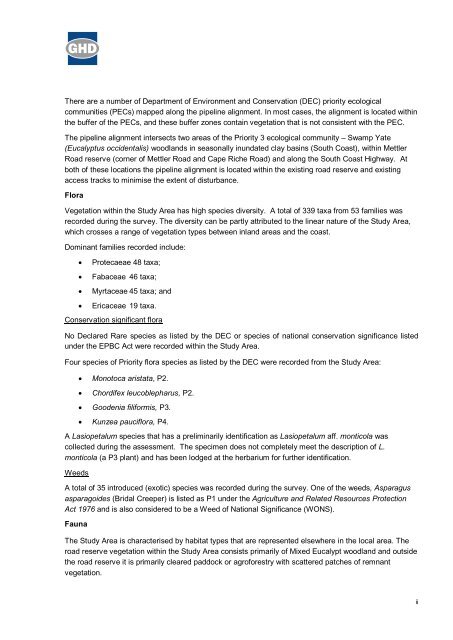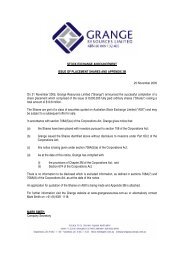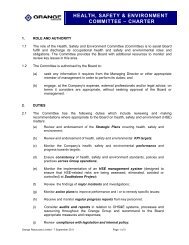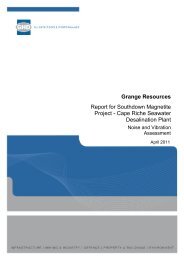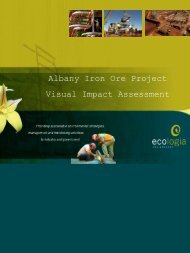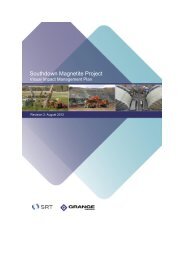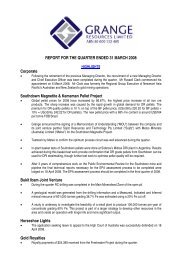Appendix A - Flora and Fauna Survey - Grange Resources
Appendix A - Flora and Fauna Survey - Grange Resources
Appendix A - Flora and Fauna Survey - Grange Resources
Create successful ePaper yourself
Turn your PDF publications into a flip-book with our unique Google optimized e-Paper software.
There are a number of Department of Environment <strong>and</strong> Conservation (DEC) priority ecological<br />
communities (PECs) mapped along the pipeline alignment. In most cases, the alignment is located within<br />
the buffer of the PECs, <strong>and</strong> these buffer zones contain vegetation that is not consistent with the PEC.<br />
The pipeline alignment intersects two areas of the Priority 3 ecological community – Swamp Yate<br />
(Eucalyptus occidentalis) woodl<strong>and</strong>s in seasonally inundated clay basins (South Coast), within Mettler<br />
Road reserve (corner of Mettler Road <strong>and</strong> Cape Riche Road) <strong>and</strong> along the South Coast Highway. At<br />
both of these locations the pipeline alignment is located within the existing road reserve <strong>and</strong> existing<br />
access tracks to minimise the extent of disturbance.<br />
<strong>Flora</strong><br />
Vegetation within the Study Area has high species diversity. A total of 339 taxa from 53 families was<br />
recorded during the survey. The diversity can be partly attributed to the linear nature of the Study Area,<br />
which crosses a range of vegetation types between inl<strong>and</strong> areas <strong>and</strong> the coast.<br />
Dominant families recorded include:<br />
� Protecaeae 48 taxa;<br />
� Fabaceae 46 taxa;<br />
� Myrtaceae 45 taxa; <strong>and</strong><br />
� Ericaceae 19 taxa.<br />
Conservation significant flora<br />
No Declared Rare species as listed by the DEC or species of national conservation significance listed<br />
under the EPBC Act were recorded within the Study Area.<br />
Four species of Priority flora species as listed by the DEC were recorded from the Study Area:<br />
� Monotoca aristata, P2.<br />
� Chordifex leucoblepharus, P2.<br />
� Goodenia filiformis, P3.<br />
� Kunzea pauciflora, P4.<br />
A Lasiopetalum species that has a preliminarily identification as Lasiopetalum aff. monticola was<br />
collected during the assessment. The specimen does not completely meet the description of L.<br />
monticola (a P3 plant) <strong>and</strong> has been lodged at the herbarium for further identification.<br />
Weeds<br />
A total of 35 introduced (exotic) species was recorded during the survey. One of the weeds, Asparagus<br />
asparagoides (Bridal Creeper) is listed as P1 under the Agriculture <strong>and</strong> Related <strong>Resources</strong> Protection<br />
Act 1976 <strong>and</strong> is also considered to be a Weed of National Significance (WONS).<br />
<strong>Fauna</strong><br />
The Study Area is characterised by habitat types that are represented elsewhere in the local area. The<br />
road reserve vegetation within the Study Area consists primarily of Mixed Eucalypt woodl<strong>and</strong> <strong>and</strong> outside<br />
the road reserve it is primarily cleared paddock or agroforestry with scattered patches of remnant<br />
vegetation.<br />
ii


